 |

Antarctica is the most isolated least-traveled region on Earth. There are hardly any planes and relatively few ships go there. That makes Antarctica one of Earth's most pristine soundscapes. Though vast stretches of Antarctica are frozen snow fields absent visible life where there is little to hear but wind, many places are rich with intriguing and ear-pleasing sounds. In this gallery of sounds you can hear stereo recordings of some of the most interesting sounds made by the wildlife and physical landscape of the Antarctic Peninsula. Try putting on a pair of headphones closing your eyes and imagining the rocky shores of Torgersen Island and the sheer ice face of Arthur Harbor. But be careful, the sounds of the elephant seals and the calving glacier are loud.
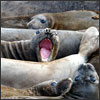
|
 |
Elephant
Seals
Elephant seals haul up on shore in wallows of a dozen or more individuals.They
fast for a month or more while they undergo what is called "catastrophic
molting," where they lose all their fur and some skin all at once.

|

|
|
Weddell
Seals
These seals make amazing sounds used for echolocation, which is a method of detecting objects like prey with sound waves. It is similar in principle to the sonar used in submarines to navigate and to identify adversaries. This particular recording was made by Dan Martin a
diver, with an underwater video camera.

|

|
|
Leopard Seal
Leopard seals are at the top of the Antarctic food chain. Apart from orcas, they have no natural predator. This group of three seals was snoring peacefully on an ice floe in the Joubin Islands.

|
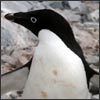
|
|
Adelie Penguins
With a local population of about 4,000 breeding pairs, Adelies are the most common penguin around Palmer Station. However their numbers have declined dramatically since 1974, when biologist Bill Fraser has been studying them. Adelies make a variety of sounds, including greeting displays, the Adelie equivalent of a gang hand shake used to help family members identify each other. Adults make calls to ward off intruders from their nests and chicks beg for food.

|

|
|
Gentoo Penguins
Gentoos are the least common penguin around Palmer, though their numbers are growing. One of the largest population is on Island Eight of the Joubin Islands, where this recording was made. If you listen closely you can also hear seagulls in the recording.

|
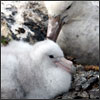
|
|
Petrel
Chick
As petrels become more mature, they want food more often than their parents can provide it. They beg incessantly. In this recording, listen for the cry of the chick and the low moan of the adult. Sometimes the chick puts its head in the adults mouth, making the gurgling sound.

|
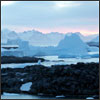
|
|
Icebergs
Cracking Up
I was searching for the underwater sound of whales singing but I got icebergs instead. This has been a banner iceberg season at Palmer station, with blocks of all sizes and shapes constantly floating by. In time, many of these majestic objects develop spires, arches cantilevers
and other structures that cannot last. When they break off, the bergs become unbalanced, and sometimes rock wildly or even flip completely over. Such jarring motions often cause addition pieces to break off in a chain reaction. Although the cracking icebergs heard in this underwater recording are quite loud, in most cases I could hear very little if anything on the surface. Whatever was making the sounds in this recording was far enough away not to be visible.

|
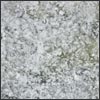
|
|
Popping Ice
Layers of snow packed down under subsequent layers turns to solid ice. The air between the flakes gets sealed into the ice inside tiny bubbles. Such glacier ice slowly migrates from where it is formed in the middle of glaciers to the edges, where it eventually breaks off and floats away.
Sometimes the trapped bubbles make a popping sound as these glacier bits warm up.

|
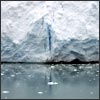
|
|
Calving Glaciers
Glaciers appear at first as solid as stone. But actually they are in constant
motion. Pieces break off as ice moves sometimes hundreds of miles from the
center toward the edges. In Arthur Harbor, the sheer face of the glacier
is riddled with cracks as hunks of ice gradually peel away from the wall
and tumble into the water below. Many times each day loud reports echo across
Arthur Harbor as large pieces crumble and fall. Sometimes a groan or thud
precedes a big crash. This recording was made about a half a mile from the
glacier, but it is still quite loud. In this recording you can also hear
the waves, caused by the calving glacier, crashing into rocks near the recorder.

|
|



